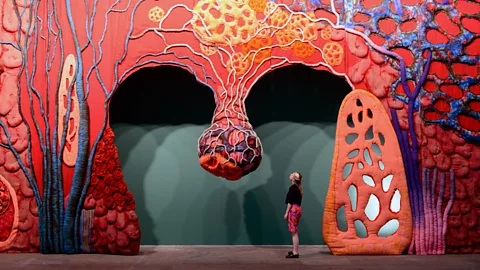Why size matters in the art world


Absolutely massive works of art are all the rage among collectors, galleries and museums, reports Georgina Adam.
This week the cavernous, gloomy Drill Hall of New York’s Armory building will be transformed by what must be one of the biggest works of art ever made. The provocative Californian artist Paul McCarthy is installing WS, a whacky forest inspired by Grimm’s fairy tales and American mythology, featuring towering trees, warped houses and grotesque videos showing lurid images unsuitable for children.
It will take 17 massive trucks just to bring in everything for the show. McCarthy is not, of course, a stranger to size – he produced the towering, 80-ft (24-m) high Balloon Dog just two months ago, in time for the Frieze New York art fair. At the same time his gallery, Hauser & Wirth, used its own vast new gallery in Chelsea – the former Roxy roller skating rink – to show more of his oversized work.
Gigantism has well and truly arrived in the art world, and in the market. At Art Basel last week, Art Unlimited, the section for XXL artworks, was even bigger than in previous years, and now boasts 11,500 sq m (123,785 sq ft) of floor space. There you could walk into whole installations – for example a room-sized cat’s cradle of black threads, chairs and a scorched grand piano, by the Japanese-born Chiharu Shiota. Or admire a giant multi-coloured balloon by the Benin artist Meschac Gaba, before trying to take in the largest painting ever shown in the section - Matt Mullican’s 22m x 7m (72 ft x 23 ft) Two into One becomes Three, 2011.
Inflated prices
The lead towards oversized art was taken by state institutions – in London, the Turbine Hall at the Tate Gallery offers 3,400 sq m (36,597 sq ft) for an artist’s project. But that size now pales beside what’s coming up in the Guggenheim museum being built in Abu Dhabi, which will have 11 such spaces for artists’ commissions. In Paris, the Monumenta project in the vast nave of the Grand Palais saw it filled in 2011 with Anish Kapoor’s Leviathan, a giant inflatable bubble-like structure.
The need for big has certainly stimulated the current trend for inflatable art. Blow-up works can be deflated, for storage and transport, but once erected can be immense. One particularly egregious example is Mark Quinn’s Alison Lapper Pregnant, a lilac-hued reiteration of the statue that was originally conceived for the fourth plinth in London’s Trafalgar Square. Towering outside the 16th century church of San Giorgio Maggiore as part of an exhibition of the British artist’s work at the Venice Biennale, the piece’s only virtue seems to be its sheer size, which jars shockingly with the Palladian architecture of its surroundings.
But who buys these monster creations? They won’t fit in anyone’s living room, that’s for sure, but they are not intended for them either. The answer is very simple: public projects but more importantly, private art spaces. These have become the ‘must haves’ of many of the wealthiest people in the world, and are driving the market for contemporary art today.
Collectors like Dasha Zhukova, partner of billionaire Roman Abramovich have space, money and ambition. And they like works with high visual impact, with the ‘wow’ factor.
Deep space
With the massive enrichment of the world, there are more alpha collectors than you might think. A small guide just published by Hatje Cantz lists 173 of these spaces, all set up by private collectors to show their art. They span the world, from Argentina to the Ukraine.
Some spaces are on a very large scale: for example, in Inhotim, Brazil, the mining billionaire Bernardo Paz has 5,000 acres (217,800,000 sq ft) to show his mainly commissioned artworks. To put this in perspective: London’s Tate Modern has a total internal floor area of 8.5 acres (370,260 sq ft). Rumour has it that Inhotim is where Anish Kapoor’s Leviathan will eventually be displayed.
Christie’s owner, the luxury-goods mogul François Pinault, has two museums in Venice to fill with his holdings: during the Venice Biennale, he unveiled two huge paintings by the Chinese artist Zeng Fanzhi, filling the central cube in La Dogana, one of these spaces.
The commercial world is also super-sizing up. Dealers such as Zwirner, Hauser & Wirth and White Cube are extending their spaces by acquiring new buildings. And of course bigger art sells for more money.
Globalisation has also had an impact on bigger art. Production costs would be prohibitive in the west for some projects, such as Ai Weiwei’s installation of sunflower seeds in Tate Modern in 2010. The 100 million seeds were hand-painted in China, something that could never have been done in the West. A number of Western artists now have studios in China, for example the Belgian Wim Delvoye or the American Kehinde Wiley.
Whether bigger is better is another debate, but there’s little doubt that ‘small is beautiful’ isn’t on today’s art market agenda. Just ask Paul McCarthy, as he installs the 700 sq m (7,534 sq ft) sculpture at the centre of the WS show….